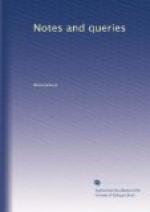The above epigram is inserted in my copy of the Rolliad.
Can any of your readers give the names of the {440} authors of the numerous pieces in the second part of “Political Miscellanies.”
F.B.R.
The Conquest.—Permit me to point out the erroneous historical idea which obtains in the use of this phrase. Acquisition out of the common course of inheritance is by our legists called perquisitio, by the feudists conquisitio, and the first purchaser (he who brought the estate into the current family) the conquereur. The charters and chronicles of the age thus rightly style William the Norman conquisitor, and his accession conquaestus; but now, from disuse of the foedal sense, with the notion of the forcible method of acquisition, we annex the idea of victory to conquisition,—a title to which William never pretended.
W.L.
Twickenham.
* * * * *
QUERIES.
BIBLIOGRAPHICAL QUERIES.
(Continued from page 421.)
(18.) What could have induced the accurate and learned Saxius (Catal. Lib. Mediol., edit. p. DXC.) to give the name Elucidarium to the first part of the Mariale of Bernardinus de Bustis? This writer, who has sometimes erroneously been reputed a Dominican, and who is commemorated in the Franciscan Martyrology on the 8th of May (p. 178.), derived his denomination from his family, and not “from a place in the country of Milan,” as Mr. Tyler has supposed. (Worship of the Virgin, p. 41. Lond. 1846.) Elsewhere Saxius had said (Hist. Typog.-Liter. Mediol., col. ccclii.) that the Mariale was printed for the first time in 1493, and dedicated to Pope Alexander VI.; and Argelati was led by him to consider the Elucidarium to be a distinct performance; and he speaks of the Mariale as having been published in 1494. (Biblioth. Scriptor. Med., tom. i. p. ii. 245.) Unquestionably the real title assigned by the author to the first part of his Sermonarium or Mariale was “PERPETUUM SILENTIUM,” and it was inscribed to Alexander’s predecessor, Pope Innocent VIII.; and, in conjunction with De Bustis’s Office of the Immaculate Conception of the Virgin Mary (sanctioned by a Brief of Pope Sixtus IV., who in 1476 had issued the earliest pontifical decree in favour of an innovation now predominant in the Church of Rome), was primarily printed “Mli,” that is, Mediolani, “per Uldericum scinzenzeler, Anno dni M.cccc.lxxxxij” (1492). Wharton, Olearius, Clement, and Maittaire knew nothing of this edition; and it must take precedence of that of Strasburg named by Panzer (i. 47.).
(19.) Can any particulars be easily ascertained relative to reprints of the acts of the canonisation of the Seraphic Doctor in their original small quarto shape?




